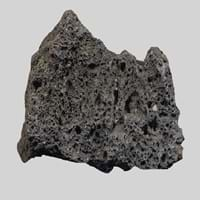Definition
Diatomite is a fine-grained sedimentary rock which is formed from consolidated diatomaceous earth
Scoria is a dark-colored extrusive igneous rock with abundant round bubble-like cavities
Discoverer
Unknown
Unknown
Etymology
From diatom + -ite1
From late Middle English (denoting slag from molten metal), from Greek skōria refuse, from skōr dung
Class
Sedimentary Rocks
Igneous Rocks
Sub-Class
Durable Rock, Soft Rock
Durable Rock, Medium Hardness Rock
Group
Not Applicable
Volcanic
Other Categories
Fine Grained Rock, Opaque Rock
Fine Grained Rock, Opaque Rock
Texture
Clastic or Non-Clastic
Vesicular
Color
Grey, White, Yellow
Black, Brown, Dark Grey to Black, Red
Durability
Non-Durable
Durable
Appearance
Soft
Glassy and Vesicular
Interior Uses
Decorative Aggregates, Homes, Interior Decoration
Decorative Aggregates, Interior Decoration
Exterior Uses
Garden Decoration, Paving Stone
Garden Decoration, Paving Stone
Other Architectural Uses
Curbing
Curbing
Construction Industry
As Dimension Stone, Cement Manufacture, Construction Aggregate, for Road Aggregate, Landscaping, Making natural cement, Source of calcium
Cement Manufacture, Construction Aggregate, for Road Aggregate, In landscaping and drainage works
Medical Industry
Not Yet Used
Not Yet Used
Antiquity Uses
Artifacts
Artifacts, Monuments, Sculpture
Commercial Uses
Alumina Refineries, Animal feed filler, As a Feed Additive for Livestock, Creating Artwork, Drawing on blackboards, Fire resistant, Gymnasts, athletes and mountain climbers use for grip, In aquifers, Soil Conditioner, To ignite fire, Used as a filter medium, Used as an insecticide, Whiting material in toothpaste, paint and paper
As a traction material on snow-covered roads, Creating Artwork, High-temperature insulation, In gas barbecue grills
Types
Not Available
Not Available
Features
Clasts are smooth to touch, Is one of the oldest rock, Smooth to touch, Very fine grained rock
Available in Lots of Colors and Patterns, Generally rough to touch, Surfaces are often shiny
Archaeological Significance
Monuments
Not Yet Used
Used
Famous Monuments
Not Applicable
Data Not Available
Sculpture
Not Yet Used
Used
Famous Sculptures
Not Applicable
Data Not Available
Figurines
Not Yet Used
Used
Formation
Diatomite rock formed from the skeletal remains of single celled plants called diatoms. When diatoms die, their skeletal remains sink to the bottom of lakes and oceans etc. hence forming diatomite deposit.
Scoria forms when magma containing huge amount of dissolved gas flows from a volcano during an eruption.
Mineral Content
Calcite, Clay, Clay Minerals, Quartz, Sand
Apatite, Biotite, Calcite, Feldspar, Hematite, Hornblade, Ilmenite, Magnetite, Olivine, Pyroxene, Quartz, Silica
Compound Content
Ca, NaCl, CaO
Ca, NaCl
Types of Metamorphism
Not Applicable
Burial Metamorphism, Cataclastic Metamorphism, Contact Metamorphism
Types of Weathering
Biological Weathering, Chemical Weathering, Mechanical Weathering
Biological Weathering, Chemical Weathering, Mechanical Weathering
Types of Erosion
Chemical Erosion, Coastal Erosion, Wind Erosion
Chemical Erosion, Coastal Erosion, Glacier Erosion
Grain Size
Very fine-grained
Fine Grained
Fracture
Not Available
Conchoidal
Porosity
Highly Porous
Highly Porous
Luster
Dull
Subvitreous to Dull
Cleavage
Non-Existent
Perfect
Specific Gravity
2.3-2.4
Not Available
Transparency
Opaque
Opaque
Density
2.49-2.51 g/cm3
Not Available
Specific Heat Capacity
Not Available
Resistance
Heat Resistant
Heat Resistant, Impact Resistant, Pressure Resistant, Wear Resistant
Deposits in Eastern Continents
Asia
Brunei, India, Indonesia, Malaysia, Singapore, Thailand, Vietnam
Afghanistan, Indonesia, Japan, Russia
Africa
Cameroon, Chad, Ghana, Kenya, Malawi, Sudan, Tanzania, Togo, Zambia, Zimbabwe
Ethiopia, Kenya, Tanzania
Europe
England, France, Germany, Spain, United Kingdom
Greece, Hungary, Iceland, Italy, Turkey
Others
Not Yet Found
Not Yet Found
Deposits in Western Continents
North America
Canada, USA
Bahamas, Barbados, Canada, Costa Rica, Cuba, Jamaica, Mexico, USA
South America
Colombia
Argentina, Chile, Ecuador, Peru
Deposits in Oceania Continent
Australia
Adelaide, New Zealand, Queensland, Tonga, Victoria, Yorke Peninsula
New Zealand, Western Australia
All about Diatomite and Scoria Properties
Know all about Diatomite and Scoria properties here. All properties of rocks are important as they define the type of rock and its application. Diatomite belongs to Sedimentary Rocks while Scoria belongs to Igneous Rocks.Texture of Diatomite is Clastic or Non-Clastic whereas that of Scoria is Vesicular. Diatomite appears Soft and Scoria appears Glassy and Vesicular. The luster of Diatomite is dull while that of Scoria is subvitreous to dull. Diatomite is available in grey, white, yellow colors whereas Scoria is available in black, brown, dark grey to black, red colors. The commercial uses of Diatomite are alumina refineries, animal feed filler, as a feed additive for livestock, creating artwork, drawing on blackboards, fire resistant, gymnasts, athletes and mountain climbers use for grip, in aquifers, soil conditioner, to ignite fire, used as a filter medium, used as an insecticide, whiting material in toothpaste, paint and paper and that of Scoria are as a traction material on snow-covered roads, creating artwork, high-temperature insulation, in gas barbecue grills.









